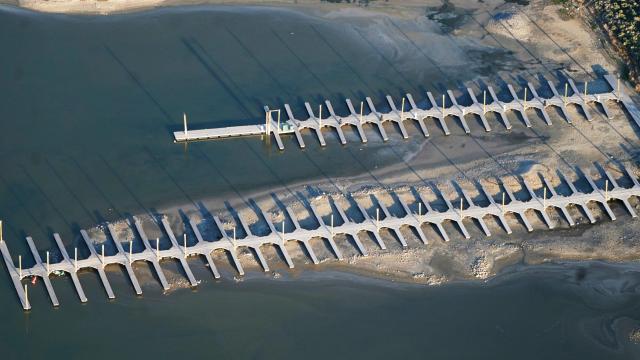Water levels in Utah’s Great Salt Lake have officially dwindled to their lowest ever recorded. It’s an effect of the megadrought that has impacted water supplies across the West.
The Great Salt Lake is the largest natural lake west of the Mississippi River, and the largest salt lake in the western hemisphere. Its health is critical not only for the environment, but local tourism and $US1.3 ($2) billion in industry such as brine shrimp and cyst harvesting and mineral extraction. While the lake’s levels regularly fluctuate dramatically, the U.S. Geological Survey now says the ongoing megadrought plaguing the region has lowered average daily water levels to about an inch below the previous record low of 4,194 feet (1,278 meters), which was set in 1963. (Utah Rivers Council, a nonprofit, declared an unofficial record low earlier this month.) According to the Associated Press, while the lake typically gains up to two feet (0.6 meters) of depth from spring runoff, this year runoff amounted to about six inches (15.2 centimeters).
More alarmingly, Candice Hasenyager, the deputy director of Utah’s Division of Water Resources, told the AP that this record was set months before water levels in the Great Salt Lake typically reach the yearly minimum. That indicates the lake could continue drying up as the summer progresses and heat continues to take its toll.
The low water levels are already a problem for pelicans that use the lake as a nesting spot, and local officials suspect that a respiratory disease that killed wild sheep in the state park at Antelope Island got there due to the formation of a land bridge linking the island to the mainland. According to the AP, owners of boats docked in the Great Salt Lake are hoisting them out of the water to avoid them getting stuck in mud. As the lake shrinks further, it could lead to more windborne arsenic dust from the dry lakebed that blows into populated areas, raising public health concerns. (Adjacent Salt Lake City already has one of the worst air quality levels in the country.) Other potential impacts include increased salinity that affects the algae, bacteria, brine shrimp, and brine flies that are the lake’s only inhabitants as well as major shifts in its geography.
A key factor in this disturbing development is the climate crisis, which has contributed to the hot, dry conditions that have worsened in the West in recent years. About 90% of the West is currently experiencing some kind of drought, which Desert Research Institute and the Western Regional Climate Centre climatologist David Simeral told Discover Magazine is a 122-year record.
The situation is particularly bad in Utah. The Drought Monitor currently shows 99% of the state is confronting “extreme” or worse drought conditions, with 70% of the state at the highest category of “exceptional” drought.
“It‘s already concerning that Great Salt Lake has been on a slow decline, but the drought has accelerated that decline,” Hasenyager told NBC News. “It’s really alarming. … This is what climate scientists have projected, that we would see more extremes and higher temperatures. And that’s what we’re seeing.”
But other human activities such as diversion of the freshwater streams and rivers that feed it towards agriculture and residential water supplies have played a major role. Water consumption by Utah’s public supply customers is the highest of any U.S. state, averaging out to between 200 and 1,136 l of water a day per person. A 2017 study concluded overuse of tributaries was the main factor in the lake’s size halving since 1847; that study concluded the amount of water that should be reaching the lake had remained relatively stable over the past 170 years.
In June, Utah Governor Spencer Cox asked the residents of the state to pray for rain to end the drought. That obviously hasn’t happened, though whether prayer is a meaningless solution or the piety of the locals wasn’t up to standards may be a matter of personal opinion.
The drought in the West isn’t expected to improve anytime soon. Ryan Rowland, the data chief at the USGS’s Utah Water Science Centre, told NBC News that “We think [the Great Salt Lake] could drop another foot to a foot and a half” over the rest of the year.
